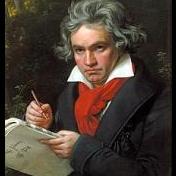Search the Community
Showing results for tags 'requiem'.
-
This is a repost of the Confutatis movement of a Requiem, I have been working on for quite awhile. I made some minor changes in the orchestration, mostly in the second half of the piece. The first half is written as a simple, mournful canon intending to depict those condemned to the "flames of woe" resigned to their fate as their punishment is carried out. The second half is intended to depict angels descending from heaven, represented by the tremolo strings, to comfort those who have been saved by their contrition.
-
Here my Dies Irae from my little Requiem I'm writing. Latin text: Dies iræ, dies illa, Solvet sæclum in favilla, Teste David cum Sibylla! Quantus tremor est futurus, quando iudex est venturus, cuncta stricte discussurus! English traduction: Day of wrath, that day in wich the centuries are reduced to ashes; as witnesses King David and the Sibyl! How much terror there will be, when the judge is about to come, to judge everything strictly! Happy for feedback! Soon I will upload the score but here is the audio:
-
This is the first time that I improvised a fugue subject and multiple countersubjects and didn't immediately come across contrapuntal errors with my Check Harmony Rules plugin in Musescore. I haven't bothered to look more in depth though(like every note kind of depth). So there might be some errors that I missed. I want to resolve these before I move further with the fugue. As you can probably tell by the PDF file, I wrote this fugue exposition with the text of a Requiem in mind, specifically, the Introit, which is the first section of a Requiem mass. Augmented intervals, those most likely have to do with the leading tone combined with the minor key and thus, shouldn't be bothered with, right, so as to not stray away from the key too fast? Or are they unacceptable, even in minor keys? Here is the fugue exposition in image form, so as to highlight the Subject and 3 countersubjects: There, that is the fugue exposition. I figured that this Requiem fugue would be one of the best fugues for which the subject appearance order would be BTAS, or in other words ascending, to represent the ascent to heaven(I'm personally not religious, but I know some things about religion). Did I obey the counterpoint rules and write a good fugue exposition with 3 countersubjects? Or are there some errors that I missed? I mainly focused on not having parallel and direct octaves, fifths, and fourths, and not having too many parallel thirds or sixths, so I might have missed errors of unresolved dissonances and weak suspensions that did not get picked up on a first pass.
-
Here the still unfinished introtius of my requiem. The opening is inspired by the Requiem in C minor of Haydn. I would appreciate feedback! 🙂
-
Hello all, I do not really know where to post this, so I am putting it here. What are the lyrics to the Requiem Mass? Is there a standard set? I am looking to write one and I cannot find the lyrics I am ?supposed? to use.
-
This piece was supposed to be an introit or "requiem" movement to a requiem I was writing until I realized I hate writing with established formats (i.e. symphony, sonata, etc.) so this piece remains as is. As such, the final buildup was planned to up an octave and take two phrases instead of one to descend the second time through, but I never wrote a "second time through" so what's here is what's here. Enjoy!
-
Since this section has been a little slow, I thought I'd repost the completed movements of my requiem. I'm almost done with the first part (Introitus and Sequentia), just needing to finish the Recordare (part VI) which I've been a little stuck. I've been making minor revisions to the other movements. I've been working on this off and on for quite a long time, since college, though more in earnest over the past couple years so it is a bit of a microcosm of my development as a composer. It initially was heavily inspired by Mozart's Requiem (I plan to setting the same text as his including the Sussmayr completion) but I've also drawn inspiration and influence from many other Classical and Romantic settings. When I get a chance, I'll post the scores as well. Any thoughts welcome!
-
Not an especially adventurous work, written in a day and a half for a funeral. I decided to upload it simply because there isn't much in the way of organ music, and the organ is the "king of instruments".
-
I have been interested for a long time in writing a Requiem. I tried to google some information but couldnt find anything. Can a Requiem be any instrumentation? So it is just the text that classifies the piece as a Requiem?









